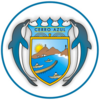Cerro Azul, Peru facts for kids
Quick facts for kids
Cerro Azul
|
|||
|---|---|---|---|
|
Village
|
|||
|
|||
| Country | |||
| Region | Lima | ||
| Province | Cañete | ||
| District | Cerro Azul | ||
| Founded | August 16, 1921 | ||
| Area | |||
| • Total | 105.17 km2 (40.61 sq mi) | ||
| Elevation | 3 m (10 ft) | ||
| Population
(2005 census)
|
|||
| • Total | 6,491 | ||
| • Density | 61.719/km2 (159.852/sq mi) | ||
| Time zone | UTC-5 (PET) | ||
| Website | municerroazul.gob.pe | ||
Cerro Azul, meaning "Blue Hill," is a lovely fishing village in the Cañete Province of Peru. It used to be a busy commercial port. This village is about 131 kilometers (81 miles) south of Lima, Peru's capital. Many people from Lima and nearby San Vicente de Cañete visit Cerro Azul, especially in the summer. Today, tourism is more important to the village than fishing.
The village is famous for its beautiful bay and rocky point. Here, waves break from left to right, making it a great spot for surfing. The quality of these waves is even mentioned in the Beach Boys' song "Surfin' Safari"! However, the waves can change throughout the year because the sand and stones on the beach move with the sea.
South of the main pier, you'll find an area called Puerto Viejo, which means "old port". This is where most holiday homes are, and it's a popular place for surfing, with waves breaking to the left. To the north of the pier, the beach is longer and sandier. It's often quiet in winter but becomes a favorite spot for campers and day-trippers in the summer. You can also surf here when the waves are big, especially near the pier.
Cerro Azul's most famous landmark is its pier. A British company built it around 1900 to help export cotton grown in the area. The pier hasn't been used for shipping for over 60 years. Now, it's a popular spot for local fishermen and tourists, making it one of the main attractions in the village.
The village also has a nice main square. You can see the remains of ancient mud buildings from before the Inca times. These buildings are partly buried by sand between two hills. One of these hills is made of the blue rock that gives the village its name. The other hill has an old lighthouse that was used when Cerro Azul was a busy port. This lighthouse sits on tall, rocky cliffs where many birds make their nests.
You might spot the Inca tern, a special bird found only along the Peruvian coast. Other animals often seen here include porpoises, pelicans, sea lions, and herons. Sometimes, you might even see sharks! In 1989, Cerro Azul proudly caught the biggest shark in Peruvian history – a 5-meter (16-foot) long great white shark. Behind the village, past the Pan-American Highway, you'll find green fields and winding valleys leading into the foothills of the Andes mountains.
History
Ancient Times
Long ago, even before the Inca Empire, Cerro Azul was a busy fishing village. It was part of a kingdom called Warku. The Warku kingdom existed at the same time as the Chimú culture further north. In Warku, society had different levels: important people lived in large homes, while others lived in smaller ones.
Every home in Cerro Azul had special rooms for drying fish. This dried fish was very important because people could trade it for other goods from outside the village. The homes of the important people even had breweries! These breweries had big fireplaces and huge pots to make chicha, a type of corn beer. This beer was likely served during big parties and celebrations.
Inca Conquest
Later, the Inca ruler Pachacuti took control of the town. To celebrate his victory and show his great power, he ordered a stone fortress to be built. This fortress, called Fortaleza de Cerro Azul, had steps leading down to the sea. Some historians say this fort was as grand and amazing as the famous Sacsayhuaman fortress.
Modern Port Use
In 1830, a special rule was made that temporarily opened the Port of Cerro Azul. This allowed goods from the Cañete valley, as well as guano (bird droppings used as fertilizer) from nearby islands, to be shipped out. This helped the local economy by making trade easier.
Images for kids
See also
 In Spanish: Cerro Azul (Perú) para niños
In Spanish: Cerro Azul (Perú) para niños





